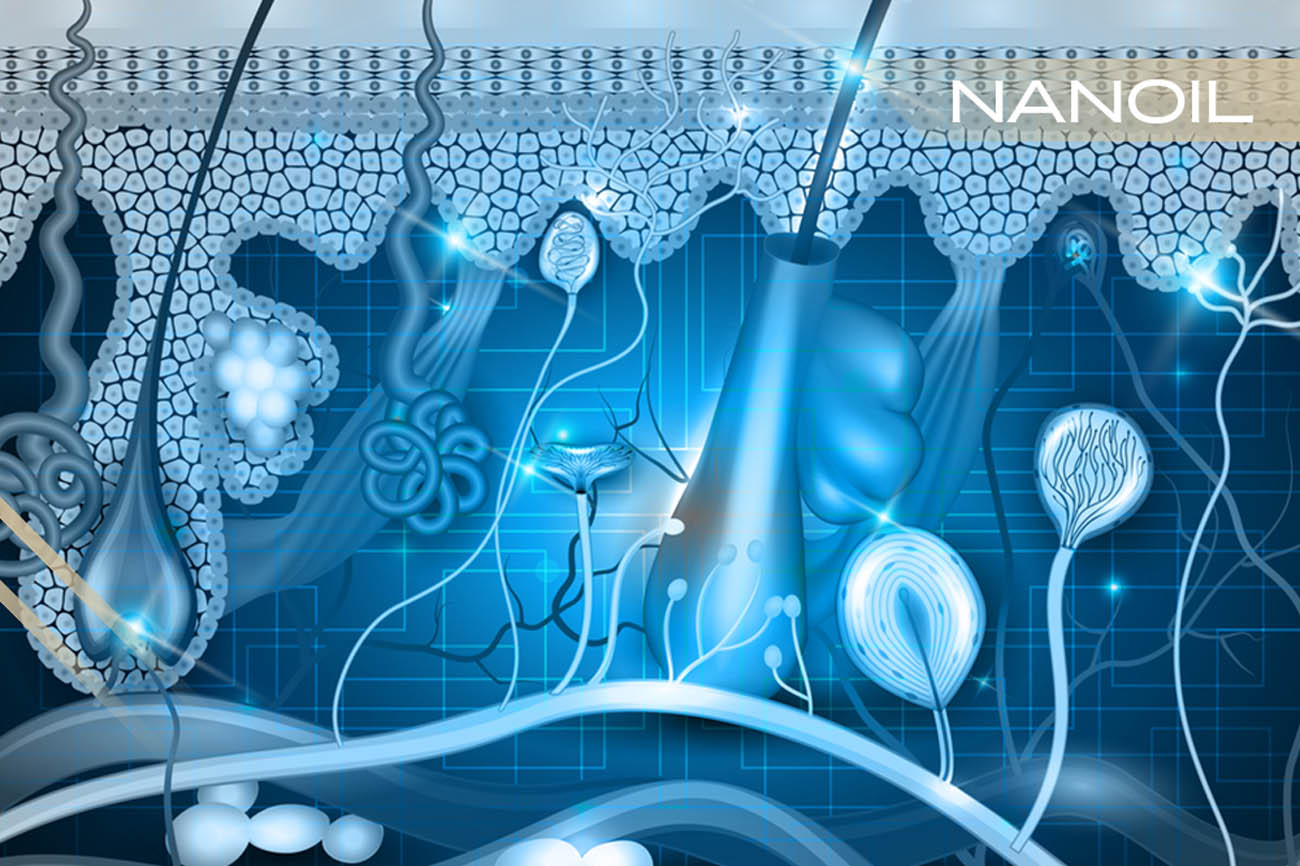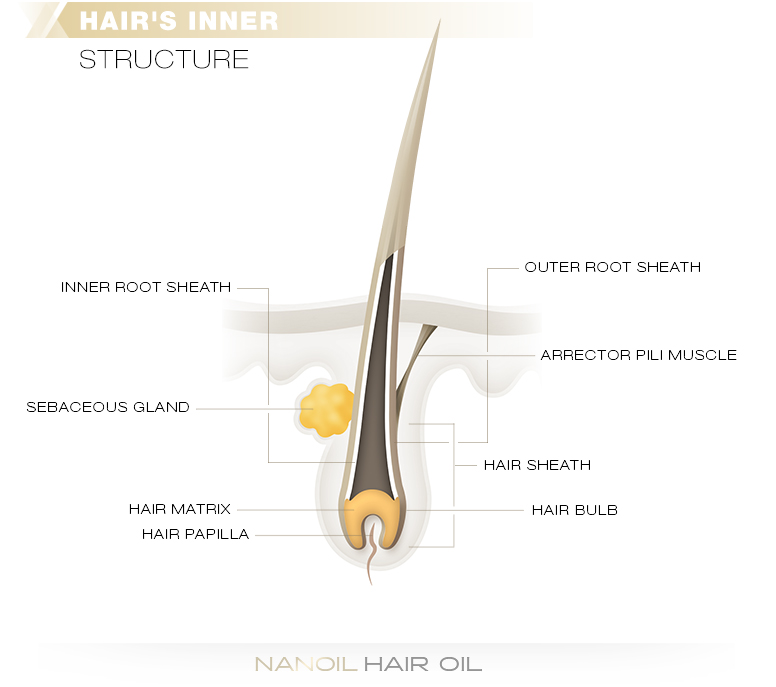- NANOIL Products
- Oils
- Face serums
- Hair masks
- Shampoos
- Hair conditioners
- Hair styling
- Hair Porosity Test
- Blog
- Contact

90 in² - it seems to be a small area, yet it constantly occupies our head... literally - after all, this is the exact size of human scalp. The hair bulbs that the scalp houses are the perfect, continuously working 'hair factory.' It can be said that our head has got a lot to deal with. Indeed, the pursuit of having beautiful and healthy hair is at the forefront of our minds. Therefore, it’s worth realising that the secret of hair well-being is hidden in its bulb. The knowledge of its structure is crucial in taking care of hair consciously and... effectively.
Let’s split hairs - how is its inner, subcutaneous structure built? What does really happen in our scalp? How can we support what can’t be seen with the naked eye, yet is essential for having outstandingly beautiful and healthy hair?
Dermis is a vast (thick) skin area located right underneath epidermis. This is where the main hair part is located, the active part that can be compared with headquarters. After all, this is exactly where all the key decisions concerning hair growth, condition and its looks are made. Hence, everything that can't be seen appears to be 'the very essence' of hair.
Hair bulb is placed in dermis. This is the only living, able to carry out cell division part of hair. In other words, this is the heart and the root which state of health determines the looks and condition of the hair shaft.

● HAIR BULB - is the place where hair comes into existence. Inside, all layers of epithelial tissues connect to create one cell conglomerate which colour can be either light (blonde) or darker (from red to black). It's hair bulb in particular where a hair shaft grows out from and where all the epithelial tissue layers surrounding it are created.
Bulbs 'live' peacefully and comfortably in a hair follicle, and its inner part is covered by the outer and inner sheath. Our organism is connected with hair bulb through capillaries that find their outlet in hair papilla. This is the very place through which all essential substances taken from organism reach hair matrix. Without the very substances proper hair growth and cell division won't be possible. Coming back to hair papilla, it houses nerve fibres that enable transporting food to bulb. In other words hair papilla grabs essential microelements to help the hair grow strong.
● HAIR SHEATH - this is a part of hair where a hair bulb is located. Hair sheath is connected with dermis due to arrector pili muscle. It’s directly to its canal that the follicular ducts of sebaceous glands, attached firmly to each hair, empty into. Sebaceous glands, in turn, are responsible for lubricating and protecting the whole hair shaft. Hair sheath is a very important hair part because it’s perceived as a kind of 'action centre’ where hair cells diversify. To clarify, hair sheath is the habitat of active and constantly multiplying stem cells. The better the hair is nourished, the more intensive (and correct) cell division is, and cells are able to divide even every 23 hours. It's quite a pace for an organism. The consequence of this process is keratin fibres synthesis that form cortex, medulla and cuticle. The cuticle layer influences the looks and condition of hair. Discussing the issue further, hair sheath is surrounded by thinner layers:
● HAIR MATRIX – it’s the subcutaneous part of hair that is one of hair sheath constituents, and to be more precise, a constituent of its bulb. In short, hair matrix is made from tissue cells and melanocytes that 'germinate' new, healthy hair. Moreover, hair matrix is perceived as the most important part of the hair root called bulb. It’s also located right under hair papilla which feeds the entire sheath and bulb. The work of cells that hair matrix houses has the direct impact on the proper hair growth processes.
● HAIR PAPILLA - is an indentation of the bottom part of hair bulb. The surface of the hair papilla features stem cells that are crucial for hair development. They are supplied with oxygen and nourishing substances through capillaries which are located closely to it.
● HAIR STEM CELLS - in other words they are progenitors of hair. Thanks to them, new (keratinocytes) hair-creating cells are produced. In order for the stem cell division process to occur faster, an appropriate amount of nutrients and oxygen molecules are necessary, and they have a profound impact on the proper hair growth. In other words, one of the most important aspects determining long, thick and strong strands is the proper matrix nourishment. This is important for hair not just to 'grow', but to grow beautiful and strong. To make it happen, stem cells must receive the right amount of nourishing substances. For that reason, stem cells must be provided with the proper supplementation like well-balanced set of hair vitamins.
Connective tissue hair sheath has its adnexa that are yet another 'bridge' between hair bulb and our body. They include the above-mentioned arrector pili muscle and sebaceous gland.
● arrector pili muscle - is a muscle that holds hair. Its function can be compared to a tent guy line - it's, so-called, a hair erector muscle. It isn't only responsible for holding hair inside hair follicle but also its contraction lifts hair to erect it. In plain English, this muscle helps our hair rise, and this is how goose bumps appear.
● sebaceous gland - as the name speaks for itself, this gland is responsible for sebum production. This substance is able to protect hair against damages. Also, sebum is able to flatten hair cuticles and smooth out its surface. What's important to realise, sebum production must be balanced. Neither too excessive nor too low influences hair condition positively.
Knowing the hair structure, action of hair bulbs and glands, and being aware of how a hair is created, it finally becomes obvious that the very core of proper hair care equals constant stimulation and nourishment of hair bulbs without neglecting the scalp where hair grows out from. In other words, in pursuit of healthy and strong hair, paying attention to hair inner structures is what matters most. These are the very hair parts that require out intensive care. Luckily, we have quite an influence on our hair condition and we can do a lot to take a proper care of it.
It's the inside that counts, so how to take care of and reinforce hair bulbs?
1. Supplementation: food for hair - carefully selected and balanced quantity of vitamins are a crucial element of proper hair care. Hair mustn’t only be supported from the outside, but form the inside, too. This means that hair should receive vitamins and nutrients that penetrate hair papilla through capillaries to enhance the cell division process and deliver substances owing to which the hair can grow strong and beautiful.
2. Improvement of blood circulation in the scalp - increased blood circulation in the subcutaneous tissue works like hair detox. Simply, it helps remove all unnecessary and potentially harmful metabolites. Moreover, scalp massage is also a perfect way of stimulating cells and blood vessels from the outside. In short, scalp massage encourages hair bulbs to more intensive work, strengthens them, supplies skin with oxygen as well as facilitates work of connective tissue hair sheath and all the other processes occurring in matrix.
3. Hair oil treatment - hair oiling is one of the finest, natural hair treatments that can be safely applied to the scalp. The molecules of oils penetrate through skin to reach bulbs and nourish them intensively. At the same time, bulbs are stimulated and significantly reinforced to combat hair loss problem. Natural oils are the source of essential fatty acids, vitamins, plant sterols and flavonoids. They are recognized as the perfect hair conditioner that nature has ever created. If performed regularly, hair oil treatment is potent enough to heal hair from the very root and enhance its structure as well as accelerate cell division. After all, hair oiling is connected with scalp massage that boosts the absorption of nourishing substances and helps skin function properly.
In order to make hair grow strong and help it astonish others with its beauty, it's worth looking at the issue of hair care form a different angle and starting to reinforce hair from its roots. Treatments that mainly focus on scalp and the bulbs the scalp houses are one of the finest that we can 'gift' our hair with.
Leave your email address and we ll notify you when it s back in stock.
Comments: #0